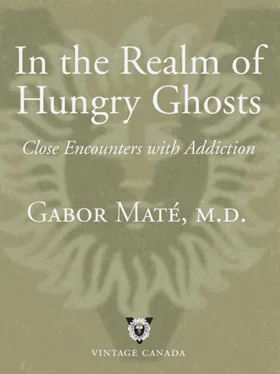Kim combines professional efficiency with humour, down-to-earth presence and a refreshing openness to the novel and different. She is also kind. She witnessed my incident with Josh and gently massaged my shoulders after Josh left the examination room.
Josh had been homeless for three years before he moved into the Portland. His paranoia, violent outbreaks and drug addiction were so out of control that he couldn’t be housed anywhere. Without the harm reduction facilities administered by the Portland Hotel Society and other organizations, many addicts and mentally ill people in the Downtown Eastside would be street nomads or, at best, migrants with five or six different addresses a year, being shunted from one dingy establishment to another. There are hundreds of homeless in the neighbourhood. As the 2010 Winter Olympics draw near, the city is predicting the numbers will rise—a prospect that some policymakers seem to regard more as a potential embarrassment than as a humanitarian crisis.
“When Josh first came, I couldn’t even get into his room,” Kim recalls. “Now, every time I go by, he wants me in to show me the mad space he lives in, and how he’s cleaning it up. You know, he took me out last week for pizza. He had to buy me pizza. I was saying, ‘No, no, I’ll buy you lunch. I have more money.’ He was adamant; this was his treat. It was the grossest pizza I’ve ever had,” Kim laughs. “I had every bite and I was like ‘Mmmm, thanks, man.’ He still refuses his medications, and he’s never going to be stable, but he’s much more approachable.”

The moments of reprieve at the Portland come not when we aim for dramatic achievements—helping someone kick addiction or curing a disease—but when clients allow us to reach them, when they permit even a slight opening in the hard, prickly shells they’ve built to protect themselves. For that to happen, they must first sense our commitment to accepting them for who they are. That is the essence of harm reduction, but it’s also the essence of any healing or nurturing relationship. In his book On Becoming a Person, the great American psychologist Carl Rogers described a warm, caring attitude, which he called unconditional positive regard because, he said, “it has no conditions of worth attached to it.” This is a caring, wrote Rogers, “[that] is not possessive, [that] demands no personal gratification. It is an atmosphere [that] simply demonstrates I care; not I care for you if you behave thus and so.” 1
Unconditional acceptance of each other is one of the greatest challenges we humans face. Few of us have experienced it consistently; the addict has never experienced it—least of all from himself. “What works for me,” says Kim Markel, “is if I practise not looking for the big, shining success but appreciating the small: someone coming in for their appointment who doesn’t usually come in…that’s actually pretty amazing. At the Washington Hotel this client with a chronic ulcer on his shin finally let me look at his legs this week, after me harassing him for six months to have a peek. That’s great, I think. I try not to measure things as good or bad, just to look at things from the client’s point of view. ‘Okay, you went to Detox for two days…was that a good thing for you?’ Not, ‘How come you didn’t stay longer?’ I try to take my own value system out of it and look at the value something has for them. Even when people are at their worst, feeling really down and out, you can still have those moments with them. So I try to look on every day as a little bit of success.”
Kim had a very difficult time around Celia’s pregnancy, as did many others among the female staff. “It was horrible to see,” recalls Susan Craigie, Health Coordinator at the Portland. “Celia was beaten up in the street the day before she delivered her baby. There she was on the sidewalk, two black eyes and a bleeding nose, screaming ‘The Portland won’t give me taxi money to get to the hospital!’ I offered to drive her. She insisted I give her ten bucks first so she could shoot up. I refused, of course, but my heart broke.”
The three of us—Susan, Kim and I—are chatting in my office on a rainy November morning. It’s “Welfare Wednesday,” the second-to-last Wednesday of the month, when income assistance cheques are issued. In the drug ghetto it’s Mardi Gras time. The office is quiet and will be until the money runs out on Thursday and Friday—and then a large group of hung-over, drug-withdrawn patients will descend upon the place, complaining, demanding and picking fights with each other. “Celia and her baby,” says Kim, pursing her lips sadly. “One of the sweetest moments I’ve ever experienced was when I heard her singing one day. I was up on her floor doing my thing and she was having a shower. She began to sing. It was an awful country song, something I’d never listen to. But I had to stand still and listen. Celia’s voice has a lot of purity in it. A pure, gentle voice. She was just belting it out. It seemed so clear to me all at once—the tone and the innocence behind it, that’s the real Celia. She kept on singing and singing for fifteen or twenty minutes. It reminded me that there are all these different components to the people we work with. On a day-to-day basis we can really forget that.
“It also gave me this happy feeling that was tinged with a little bit of sadness. Her life could have been so different, I thought. I try not to have such thoughts in my day-to-day work…I try to take people as they are at any moment and support them that way. Not judge them or think of an alternative reality they could have, because we could all have alternative realities. I don’t focus on my own ‘What ifs’ much, so I try not to focus on other people’s. Only…there was this split second when I had two images in my brain: Celia at the worst moments I’ve seen her and then Celia singing to her kids, living on a farm somewhere with her family…And then I dropped both images and just listened to that lovely voice peacefully drifting towards me.”

To Whom It May Concern:
You do not know me, although the name on the envelope might ring a Bell. I am the individual who took your son’s life…on the 14 thof May, 1994.
Remy’s voice is tremulous with excitement or, perhaps, anxiety. He’s a short, slender man with a pallid countenance peppered with grey stubbles to match his prematurely greying hair. He’s standing in front of the open Hastings Street window. Over the hum of traffic that vibrates into the room, he reads the words from a crumpled and stained piece of foolscap. “Man,” he says, “you don’t know what this means to me, that I wrote this and that I can read it to you. Mind you, I don’t know if I’ll ever send it.”
It took a Ritalin prescription to help Remy unburden his mind. He has severe Attention Deficit Hyperactivity Disorder (ADHD). Never diagnosed before, he was dumbfounded when I told him about the lifelong patterns of physical restlessness, mental disorganization and impulse-regulation deficiencies that characterize the condition. “That’s me all over,” he kept repeating, hitting his forehead with his palm again and again. “How did you know that much about me? That’s been me since I was ankle high to a flea!”
Remy’s conversation is always an exercise in circumlocution. He launches into tirades on any topic, not recalling what he already said or where he was intending to go. He meanders, becoming snagged on the brambles of one thought, getting lost in the bushes of the next. He doesn’t know how to stop the flow of words. Some authorities see ADHD as an inherited neurophysiological dysfunction, but in my view such psychological agitation has a deeper source. Remy’s wandering speech patterns are attempts to escape an agonizing discomfort with his own self.
Читать дальше













